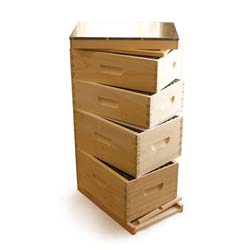A honeybee swarm is a natural part of colony reproduction and can be a sign of a strong, growing hive. However, beekeepers prefer to prevent swarming when possible, as it means losing about half the colony along with the queen. If a colony determines that their current home no longer meets their needs, they may collectively choose to swarm, and around half of the bees in the colony will leave to find a new home.
As the spring weather and warm temperatures bring blooming flowers with abundant nectar, bees may start to feel the pressure that comes along with that influx. Hive capacity is a big reason for bees choosing to swarm. If there are lots of resources available but no space to store nectar or lay eggs, the colony may feel overcrowded and obligated to search for a new home with more space. Temperature and genetics play a big part in swarming, too. Some races of honeybees are naturally more likely to swarm than others, especially in climates where heat and humidity are high, making it even more difficult for bees to manage hive capacity and temperatures inside.
Swarming is an important natural method of colony reproduction, but to try and prevent it in your bee yard, pay close attention during hive inspections to things like whether there’s enough storage space for both nectar or honey and pollen, as well as ample space for the queen to lay eggs in the brood nest.
Stress may also cause bees to swarm, so be sure to help them out by remaining conscious of any stresses they could be experiencing. To mitigate stress, consider the following tasks: avoid mowing too close to your beehives when bees are already stressed in any way, add an extra box or some empty frames to give bees more space, and if robbing pests are an issue, add an entrance reducer to help keep them out of the hive. Whether the threat of a swarm is imminent or not, beekeepers should always keep an eye out for signs of threats to bees from diseases, varroa mite infestations, or other pests (like small hive beetles) that may be further stressing bees.
Read More
During & After a Honeybee Swarm
Recognizing and Avoiding Swarms
A New Beekeeper’s Journal – Interesting Developments with Queens and Swarms
Introduction to Capturing and Installing a Swarm of Honeybees *
How Bees Manage Temperature and Moisture *
* Colony Member-Only Content
Related Products in the PerfectBee Store
All Nucs and Swarm Retrieval Products
